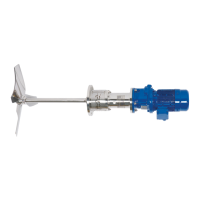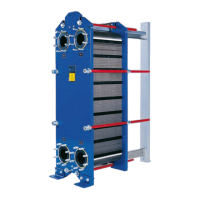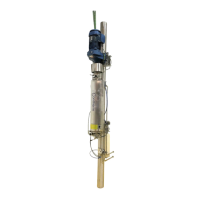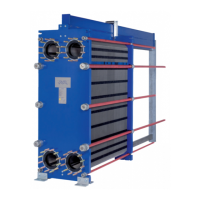Do you have a question about the Alfa Laval AQ Series and is the answer not in the manual?
Details on operational requirements, prior knowledge, PHE drawings, warranty conditions, and advice.
Information on unpacking, maintenance, and scrapping procedures with environmental considerations.
Guidelines for safe operation, maintenance, and potential consequences of incorrect handling.
Defines warning, caution, and note symbols used in the manual for hazard communication.
Details the main components of the heat exchanger, including frame plate, carrying bar, plate pack, etc.
Explains the information found on the heat exchanger's name plate, including type, serial number, and operating limits.
Describes how the heat exchanger works, including heat transfer through plates and fluid direction.
Explains multi-pass configurations and their purpose in changing fluid flow direction.
Details how to identify the A side and asymmetric patterns of the plates for gasket placement.
Precautions and checks to perform before installing the heat exchanger, including piping and foundation.
Details space, foundation, elbow, shut-off valve, and connection requirements for proper installation.
Provides instructions and safety precautions for lifting the heat exchanger using approved equipment.
Step-by-step guide for raising the heat exchanger from its packaging, emphasizing safe strap usage.
Detailed steps and precautions for starting up the heat exchanger, including checks and valve operations.
Guidelines for operating the heat exchanger, monitoring temperatures and pressures, and safety during operation.
Procedure for safely shutting down the heat exchanger, including draining and potential rinsing.
Explains CIP equipment for cleaning, including purposes and necessary protective measures.
Instructions for opening the heat exchanger for manual cleaning, including safety precautions and bolt identification.
Guidance on manual cleaning of opened heat exchanger units, including precautions and chemical use.
Instructions for properly closing the heat exchanger after maintenance, including gasket and bolt procedures.
Specific instructions for closing the TL15 model of the heat exchanger, focusing on sealing surfaces and bolts.
Procedures and safety recommendations for performing hydrostatic leakage tests after maintenance.
General procedures and considerations for replacing gaskets on heat exchanger plates.
Instructions for storing the heat exchanger in its packing box, including environmental conditions and precautions.
Specific recommendations for indoor storage conditions, temperature, humidity, and avoiding damaging agents.
Precautions for storing the heat exchanger outdoors, including visual checks and packing restoration.
Procedures for taking the heat exchanger out of service, including draining, covering, and preparing for long-term storage.
Steps for re-starting a heat exchanger after extended periods of inactivity, focusing on gasket relaxation.
| Brand | Alfa Laval |
|---|---|
| Model | AQ Series |
| Category | Industrial Equipment |
| Language | English |











